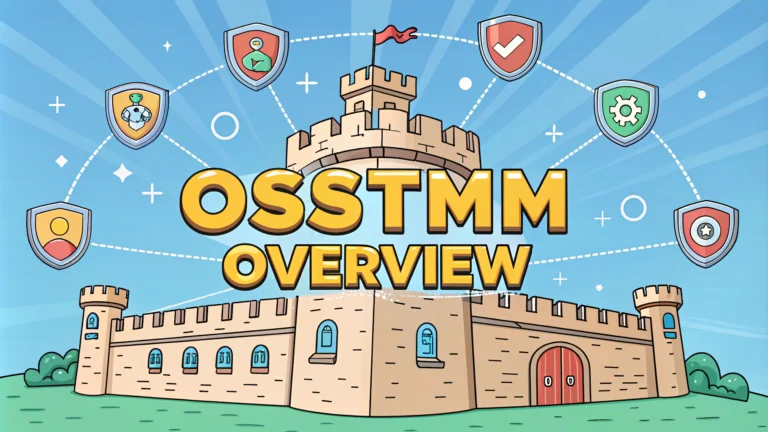The Open Source Security Testing Methodology Manual (OSSTMM) provides a scientific methodology for accurately characterizing operational security through examination and correlation of test results.
OSSTMM breaks security testing into 5 key channels:
- Human Security (HUMSEC)
- Physical Security (PHYSSEC)
- Wireless Communications (SPECSEC)
- Telecommunications (COMSEC)
- Data Networks (DATASEC)
Each channel contains specific test modules and methodologies for thorough security assessment.
Key Components of OSSTMM Testing
- Regulatory Compliance – Verifying adherence to laws and industry standards
- Posture Assessment – Evaluating security controls and policies
- Trust Verification – Testing access controls and authentication
- Controls Validation – Checking effectiveness of security measures
- Process Verification – Reviewing security processes and procedures
Benefits of Using OSSTMM
- Provides consistent, measurable results
- Creates repeatable testing processes
- Generates metrics for security posture
- Enables comparison between different systems
- Helps prioritize security improvements
The methodology uses RAVs (Risk Assessment Values) to quantify security metrics and create comparable scoring.
Practical Implementation Tips
- Start with scope definition and channel selection
- Document all testing procedures thoroughly
- Follow the sequential testing modules
- Calculate RAVs after completing each channel
- Generate comprehensive reports with metrics
Get the latest OSSTMM documentation from ISECOM’s official website.
| Testing Phase | Key Activities |
|---|---|
| Information Phase | Gathering intel, documentation review |
| Interactive Controls Testing | Authentication, access controls, process validation |
| Process Testing | Security awareness, incident handling, alert verification |
| Configuration Testing | Systems hardening, patch management, security controls |
Contact ISECOM at [email protected] for training and certification options.
Test Execution Framework
OSSTMM provides a structured framework for executing security tests across all channels. This ensures comprehensive coverage and consistent results.
Test Phases Structure
- Phase A: Regulatory Verification
- Phase B: Definition and Documentation
- Phase C: Interactive Testing
- Phase D: Results Analysis
Metrics and Measurements
RAV calculations incorporate multiple security factors to provide objective security measurements:
- Operational Security (OpSec)
- Loss Controls
- Limitations
- Controls
- True Protection
Security Metrics Categories
| Category | Measurement Focus |
|---|---|
| Visibility | Asset exposure and accessibility |
| Access | Entry points and authentication |
| Trust | Third-party dependencies |
Conclusion
OSSTMM provides a comprehensive framework for security testing that enables organizations to:
- Establish baseline security measurements
- Identify security gaps systematically
- Implement measurable improvements
- Maintain consistent security standards
Success in OSSTMM implementation requires commitment to methodology principles, thorough documentation, and continuous monitoring of security metrics.
FAQs
- What is OSSTMM (Open Source Security Testing Methodology Manual)?
OSSTMM is a comprehensive security testing methodology framework that provides a scientific approach to security testing and analysis of operational security. It was developed by Pete Herzog and ISECOM to provide a standardized way to perform security assessments. - What are the main channels of OSSTMM security testing?
OSSTMM covers five main channels: Physical Security (PHYSSEC), Human Security (HUMSEC), Telecommunications Security (COMSEC), Wireless Security (SPECSEC), and Data Networks Security (DATASEC). - How does OSSTMM differ from other penetration testing methodologies?
OSSTMM focuses on operational security metrics and provides a mathematical approach to security measurement through RAVs (Risk Assessment Values). It emphasizes testing actual security controls rather than just identifying vulnerabilities. - What is the OSSTMM trust verification process?
The trust verification process in OSSTMM involves testing security across four types of interactions: Authentication, Indemnification, Subjugation, and Continuity, measuring how well security controls maintain trust boundaries. - What is an OSSTMM audit?
An OSSTMM audit is a structured security assessment that follows specific methodologies to measure operational security, including visibility, access, trust, and security controls within a defined scope. - What are OSSTMM RAVs (Risk Assessment Values)?
RAVs are quantitative measurements used in OSSTMM to calculate the actual security level of a target by considering operational security, controls, limitations, and vulnerabilities, providing a mathematical security metric. - How does OSSTMM handle compliance testing?
OSSTMM incorporates compliance testing by mapping security controls and measurements to various regulatory requirements while maintaining its scientific approach to security testing. - What documentation is required for OSSTMM testing?
OSSTMM testing requires detailed documentation of scope, methodology, test cases, results, and RAV calculations. It includes attack surface analysis, control verification, and limitation identification documentation. - What is the OSSTMM security testing cycle?
The testing cycle consists of four phases: Review (gathering information), Investigation (identifying targets and processes), Interference (testing security controls), and Intervention (verifying results and reporting). - How does OSSTMM address social engineering testing?
OSSTMM includes specific methodologies for testing human security (HUMSEC) through controlled social engineering tests, measuring human interaction security controls and awareness levels.







